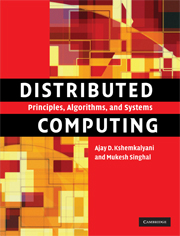Book contents
- Frontmatter
- Contents
- Preface
- 1 Introduction
- 2 A model of distributed computations
- 3 Logical time
- 4 Global state and snapshot recording algorithms
- 5 Terminology and basic algorithms
- 6 Message ordering and group communication
- 7 Termination detection
- 8 Reasoning with knowledge
- 9 Distributed mutual exclusion algorithms
- 10 Deadlock detection in distributed systems
- 11 Global predicate detection
- 12 Distributed shared memory
- 13 Checkpointing and rollback recovery
- 14 Consensus and agreement algorithms
- 15 Failure detectors
- 16 Authentication in distributed systems
- 17 Self-stabilization
- 18 Peer-to-peer computing and overlay graphs
- Index
2 - A model of distributed computations
Published online by Cambridge University Press: 05 June 2012
- Frontmatter
- Contents
- Preface
- 1 Introduction
- 2 A model of distributed computations
- 3 Logical time
- 4 Global state and snapshot recording algorithms
- 5 Terminology and basic algorithms
- 6 Message ordering and group communication
- 7 Termination detection
- 8 Reasoning with knowledge
- 9 Distributed mutual exclusion algorithms
- 10 Deadlock detection in distributed systems
- 11 Global predicate detection
- 12 Distributed shared memory
- 13 Checkpointing and rollback recovery
- 14 Consensus and agreement algorithms
- 15 Failure detectors
- 16 Authentication in distributed systems
- 17 Self-stabilization
- 18 Peer-to-peer computing and overlay graphs
- Index
Summary
A distributed system consists of a set of processors that are connected by a communication network. The communication network provides the facility of information exchange among processors. The communication delay is finite but unpredictable. The processors do not share a common global memory and communicate solely by passing messages over the communication network. There is no physical global clock in the system to which processes have instantaneous access. The communication medium may deliver messages out of order, messages may be lost, garbled, or duplicated due to timeout and retransmission, processors may fail, and communication links may go down. The system can be modeled as a directed graph in which vertices represent the processes and edges represent unidirectional communication channels.
A distributed application runs as a collection of processes on a distributed system. This chapter presents a model of a distributed computation and introduces several terms, concepts, and notations that will be used in the subsequent chapters.
A distributed program
A distributed program is composed of a set of n asynchronous processes p1, p2, …, pi, …, pn that communicate by message passing over the communication network. Without loss of generality, we assume that each process is running on a different processor. The processes do not share a global memory and communicate solely by passing messages. Let Cij denote the channel from process pi to process pj and let mij denote a message sent by pi to pj. The communication delay is finite and unpredictable.
- Type
- Chapter
- Information
- Distributed ComputingPrinciples, Algorithms, and Systems, pp. 39 - 49Publisher: Cambridge University PressPrint publication year: 2008



